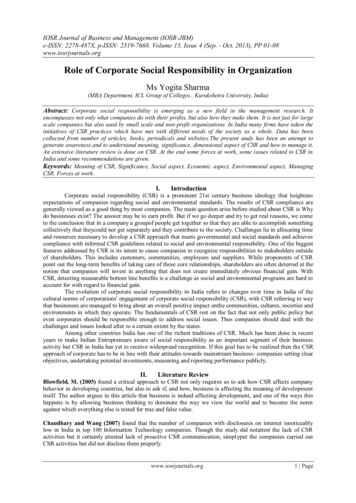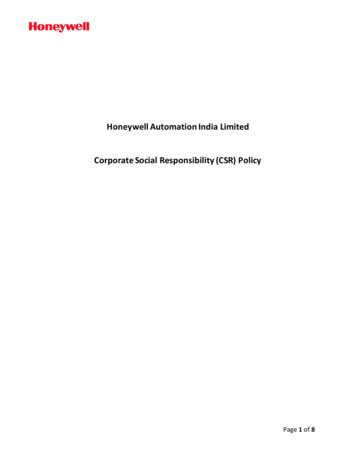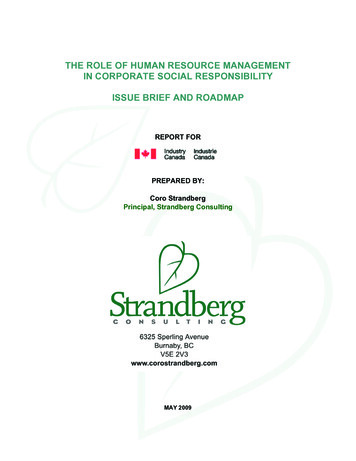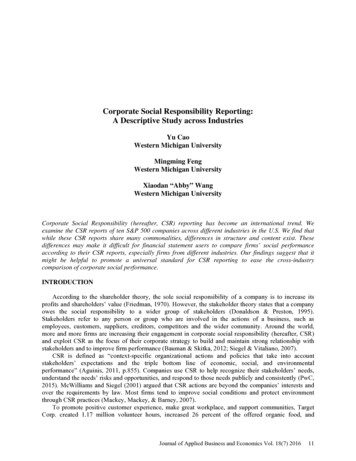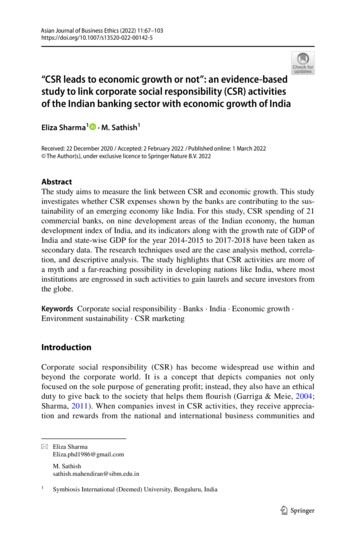
Transcription
Asian Journal of Business Ethics (2022) 2-5“CSR leads to economic growth or not”: an evidence-basedstudy to link corporate social responsibility (CSR) activitiesof the Indian banking sector with economic growth of IndiaEliza Sharma1· M. Sathish1Received: 22 December 2020 / Accepted: 2 February 2022 / Published online: 1 March 2022 The Author(s), under exclusive licence to Springer Nature B.V. 2022AbstractThe study aims to measure the link between CSR and economic growth. This studyinvestigates whether CSR expenses shown by the banks are contributing to the sustainability of an emerging economy like India. For this study, CSR spending of 21commercial banks, on nine development areas of the Indian economy, the humandevelopment index of India, and its indicators along with the growth rate of GDP ofIndia and state-wise GDP for the year 2014-2015 to 2017-2018 have been taken assecondary data. The research techniques used are the case analysis method, correlation, and descriptive analysis. The study highlights that CSR activities are more ofa myth and a far-reaching possibility in developing nations like India, where mostinstitutions are engrossed in such activities to gain laurels and secure investors fromthe globe.Keywords Corporate social responsibility · Banks · India · Economic growth ·Environment sustainability · CSR marketingIntroductionCorporate social responsibility (CSR) has become widespread use within andbeyond the corporate world. It is a concept that depicts companies not onlyfocused on the sole purpose of generating profit; instead, they also have an ethicalduty to give back to the society that helps them flourish (Garriga & Meie, 2004;Sharma, 2011). When companies invest in CSR activities, they receive appreciation and rewards from the national and international business communities and* Eliza SharmaEliza.phd1986@gmail.comM. Sathishsathish.mahendiran@sibm.edu.in1Symbiosis International (Deemed) University, Bengaluru, India13Vol.:(0123456789)
68E. Sharma, M. Sathishforums because these investments directly contribute towards economic growth(Sharma, 2011). More importantly, all the multinational firms eagerly contribute to the welfare of their fellow citizens and other developing countries. In thiscontext, financial institutions, especially banks, have been working hard to buildthe brand image as community-based institutions, resulting in better profitability, sustainability, and long-term success (Bihari & Pradhan, 2011; Deegan, 2000;Yuan et al., 2011). Researchers have observed evidence of a positive relationship between the firm’s CSR project investments and the performance of financialinstitutions, especially in the banking sector (Mansoor, 2016).Various sectors are contributing towards economic development by investingin CSR projects. Still, the banking sector is the only sector that supports projectslike community development, education and skill development, environmentalsustainability, healthcare, rural development projects, sports, and welfare, especially in women empowerment which is directly contributing towards to economic growth (Ramasamy & Ting, 2004; Mansoor, 2016; Siegel & Vitaliano,2007). Many researchers proved the link between CSR and bank performance(Chen et al., 2018; Gond & Herrbach, 2006; Swarnpali & Le, 2018; Ting, 2020).The interesting observation is that the specific link between banking sectorgrowth and economic growth is proved by many researchers (Margolis & Walsch,2003; Navarro Espigares & Lopez, 2006; Skare & Golja, 2014), so the Indianbanking sector is considered for this study. If the banks invest seriously in CSRactivities, it should reflect on their performance, so it proved that the spendingon these activities impacts their performance, but are these investments makinga tangible impact on the economic indexes? The direct link between CSR anda country’s economic growth was not measured even though regulatory bodieshave made it compulsory for the companies and banks to invest 2% of their netprofits for CSR. Earlier the CSR activities performed by banks were out of theirown choice or will and the availability of funds, but now it is mandatory (Khandelwal & Swarna, 2014). Hence, the banks should invest a certain amount in CSRactivities every year. The disclosure principle made it more difficult for the banks,as they need to disclose various details like when the CSR activities happened,where they happened, and how much they have spent on CSR activities in a year.The multiple indexes like income index, education index, employment rate, andhealthcare index are considered indirect measures for any developing country’seconomic growth (Howell et al., 2003; McGrath, 2011). The banking industryspend CSR investments in projects related to rural development projects, education, skill development, and accessible healthcare, which have a direct impact onthe various indexes of economic growth (Perrini et al., 2011; Wagner, 2010).The motive of regulatory agencies was clear while forming the CSR Act, 2014,to make all the profit-making corporates give back to society in the form of CSRsome part of their profits or help the government develop the economy (Khandelwal & Swarna, 2014). As the funds or resources available to the government arenot adequate to grow the economy rapidly to achieve high growth rates, corporates should also contribute towards this goal of sustainable development (Maxwell et al., 2000; Mcwilliams & Siegel, 2001).13
“CSR leads to economic growth or not”: an evidence-based study 69Banking is the only industry investing a considerable amount of money in highvolume projects compared to other sectors; besides, these CSR projects are highlycorrelated towards the country’s economic development (Guiral, 2012; Sharma,2011). These CSR activities include education, community development, womenand child development, the healthcare sector, and livelihood projects, but thenation’s growth is too slow. But still, these investments did not make a significantimpact on any index that uses the measure for economic growth. The government isstruggling to provide better healthcare services to its citizens, and the literacy rateis far too less for India. The unemployment rate among youth is around 23%, whichdepicts its miserable side (Acharya, 2006; Juscius, 2007; Macmillan et al., 2003;Netar, 2017; Szczuka, 2015). India has not placed in the top 50 nations in the HDIranking. There is no evidence of improving the economic index even after investingreasonably in these projects. Are these investments funded, or are only the numbersshown by the banks? This dilemma leads our research study, and this paper investigates these arguments.From 2014 onwards, all the listed banks and companies started contributing2% of their net profits to the CSR, and there are many amendments made in thisAct afterward (Khandelwal & Swarna, 2014). Due to COVID-19, regulators haveannounced that companies can deposit an equal amount of CSR in the Prime Minister’s Relief Fund. It is considered to fulfill its obligations for CSR (Business Today,2020). Since 2014, when the CSR Act came into existence, the total amount of CSRspent by companies stood at 10066 crores which increased up to 13,624 crores untilthe end of the financial year 2017-2018, covering 28 different development areasand all the 36 states and UTs of India (refer to Table 1). It is observed that the contribution of government companies had declined gradually over the last 4 years,from 2816 crore to 2553 crore, while non-government companies have contributed7249 crores in 2014, which increased up to 11,070 crores in 2018. The amount spenton CSR activities by the listed companies was around 1832 crores in 2014 and 2102crores in 2018. But the unlisted companies spent around 14,716 crores in 2014,increasing to 19,295 in 2018.Companies that have contributed above 50 lakhs to 1 crore for CSR were 662 in2014, increasing to 1072 in 2018. The deep insights into these numbers have madethe researcher rethink and motivated to research whether it is valid in all sense. Thefinancial institution’s reputation entirely relies on its socially responsible programsand related investments (Poolthong & Mandhachitara, 2009), so that only bankinginstitutions tend to have a high ranking on the international CSR investment rankingindex, which will impact the national level indexes (Perez et al., 2013). The banking sector has made significant transformations in the last few years. It has becomeone of the main proactive CSR activities worldwide (Marin et al., 2009; Truscottet al., 2009) because these investments are highly correlated to the national levelindexes. The economic index for evaluating CSR investments is a widely used literature (McGuire et al., 1988; Spencer & Taylor, 1987; Waddock & Graves, 1997).In the past, selling stake by HDFC bank to a Chinese bank, continuously increasing NPAs of the banks due to significant loan defaulters, and RBI’s efforts to makethe Indian banking sector achieve the minimum efficiency level at least. This scenario started with the failure of YES Bank.13
0172017-2018Total CSR (crores)Year2553329542142816Government organizations’contribution (in crores)Table 1 CSR expenditures from 2014 to 2018 (source: National Portal for CSR)11,07011,03310,3027249Non-govt organizations’ contribution (in crores)107211701155662Number of organizations contributingCSR from 50 lakh to 1 crore23,48923,00818,4239352Numberof CSRprojects70E. Sharma, M. Sathish
“CSR leads to economic growth or not”: an evidence-based study 71The Indian banking sector has reached the current phase of struggling from aglorious degree due to a lack of transparency and several loopholes in the system.Besides, Indian banking sector had intense competition and started taking CSRactivities very seriously (Fatma & Rahman, 2014). Some banks have mentionedthe amount in the annual report is not used for CSR activities. In this decade, eventhough regulatory bodies made CSR spending mandatory, banks are willing tospend the real money because it helps establish brand identity and brand positioning among the consumers (Georgiadou & Nickerson, 2021). Indian banks are usingthis as one of the marketing strategies to improve their ranking and rating voluntarybecause consumer recalling power and brand loyalty is very high (Fatma & Rahman,2014). During COVID, RBI insisted the banks transfer the unspent amount of CSRconverted into CSR corpus to the PM relief fund for national causes, so banks werehighly tuned towards spending these investments voluntarily for their brand-buildingexercises.The misrepresentation of facts or authenticity of the disclosures by the bankingsector got highlighted and raised numerous questions on the considerable amount ofCSR to spend by the banks while facing a massive amount of NPA and other losses.But the economic development index is telling a different story. Bank’s investmentsin the last 3-5 years should reflect in the indexes which are directly connected tothe country’s economic development. But the index results depict that the economicgrowth is not that proportionate to the investment done by the bank. But many companies are contributing a massive amount to CSR, so why is the country’s economicgrowth still too low? Are the banks using these CSR activities as only brand-building exercises and marketing tools for their better brand visibility?The Indian banking sector is a highly contributing sector towards economicgrowth. It tends to be responsible towards society, as it involves a direct interest ofthe general public. This is one of the fundamental reasons why banking institutionsfocus more on CSR activities (Perez et al., 2013). Despite the increasing interestin CSR in this industry, no studies have measured the impact of CSR activities inthe banking industry on the country’s economic growth, especially in developingeconomies like India, so the present study focuses on the Indian banking sector, andthe main objective is to identify the association between CSR and economic growth.This dilemma leads to another aspect: Is there any transparent approach that helpsthe banks invest in suitable projects that support the country’s economic growth?The following research questions are framed based on this argument.RQ1: Whether CSR activities of the bank contribute to Indian economic growthor not?RQ2: Are CSR activities used only as a marketing tool by the banks?RQ3: Is there any approach for banks to make practical CSR activities that leadsto better economic development?In the present study, the researcher has tried to link the economic growth withthe CSR spending of the banks. Later on, the discussion has been made related tothe CSR Act, contradictory disclosure of the unspent amount of CSR with the companies, and no perceptible change in the Indian economy despite an enormous CSR13
72E. Sharma, M. Sathishspending by banks. This paper focuses on whether CSR is a myth or fact and howbanks use CSR activities as a marketing tool. Finally, this paper will suggest practical approaches for government and policymakers to make CSR activities moreimpactful and long-lasting, which will impact economic growth. Researchers havefirst focused on finding out the relation between CSR activities and economic development. Once it proved there is no significant relationship between CSR activitiesand economic growth, researchers have further explained the reason using the “YESBank” case. YES Bank is failed in the market, being part of index ranking for CSRactivities and sustainability, whereas in non-of the bankers cannot be part of the listeven though they are substantial in terms of customer base and total assets. Hence,the study will prove both the parts of the statement “CSR as a “myth” or a “fact.””Review of literatureThe literature review is divided into two parts: the first part focused on studies thatestablished the link between CSR and economic growth. The second part of thepaper is how banks use CSR as a marketing tool and proposal on the better approachof CSR activity investment which has a direct impact on economic development.CSR activities contribute to economic growthAs per Table 2, various CSR activities practiced by the banks have a positive andsignificant contribution to the economic development of any nation. CSR activities include rural development projects, protection of the environment by effectiveutilization of resources (Mahapatra & Mohanty, 2013) and carbon footprints (Tilton, 2003; Castro, 2004), and development of infrastructural facilities for providingprovision of healthcare facilities to the individuals (Howell et al., 2003; Vastradmath, 2015; Verma & Chauhan, 2007). The institutions establish multiple business ventures across the rural and remote areas to enable the residents to becomeself-reliant (Mishra & Modi, 2012; Netar, 2017). In contrast, some are making theirefforts towards providing life-supporting healthcare services to improve the livingstandards of the underprivileged sector of society (Wong et al., 2011). Sen (2017)documented that the organizations involved in diverse spheres to pursue their CSRactivities view the social and environmental dimensions (Verma & Chauhan, 2007).Numerous researchers also support it (Dobers & Halme, 2009; Lee-Davis, 2017;Navarro Espigares & Lopez, 2006; Valor, 2005) that these activities like educationand skill development are linked to increasing income and reducing unemployment and growth rate of the economy. Various indexes like income index, education index, gender development index, human development index, inequality index,unemployment rate, life expectancy rate, and natural depletion rate are the variousindexes that measure the economic growth of the country (Tang et al., 2012).Unlike the banking industry, every industry contributes to the national economyby investing its money in CSR activities. Still, the banking industry’s contributionis higher than any other industry, leading to a better national economy (Tang et al.,13
Kao et al. (2018)Vastradmath (2015)Mishra and Modi (2012)345Belal and Momin (2009)Visser (2009)10Cultural tradition, political reforms, socio-economicpriorities, governance gaps, crisis response, international standardization, investment incentives, stakeholder activism, economic responsibilitiesSocial and environmental issues, health issues, andGDPPositivePositiveAsia-Pacific and African regionsDeveloping countries in Africa, Asia, and LatinAmericaPositive9Return on assets (ROA), CSR and firm profitability,firm profitability, risk and crisis management, environmental reporting, corporate governanceUSAManescu (2011)8PositiveFontaine (2013)7NetherlandsPositiveIndiaMahapatra and Mohanty (2013) environmental sustainability, social sustainability,human development index, global reporting initiative,education index, global warming/greenhouse effect,The Happy Planet Index, The Kyoto Protocol, Sustainable Development Goals6Value creation, risk management, corporate philanthropy, reduction in the unemployment ratePositivePoverty alleviation, environmental sustainability, educa- Indiation, executive coaching and training, health and food,infrastructurePositive lationshipIndiaSocial responsibility programs, health services, education, environment, infrastructure developmentSocial responsibility, operating performance, socialcontribution, public image, education indexChinaZhang et al. (2019)2GDP, income disparity, urban poverty, human rights,resource exploitation, environmental degradation,industrialization and urbanization, income indexTechnical efficiency score, macro variables, CSR (envi- 41 developed countriesronment, social, and governance)Belasri et al. (2020)1CountryParametersS.N CitationTable 2 CSR activities contributed to economic growth“CSR leads to economic growth or not”: an evidence-based study 7313
13Environmental management, pollution rate, humandevelopment index (HDI), adult literacy, and GDPDobers and Halme (2009)Reinhardt et al. (2008)Verma and Chauhan (2007)Ward et al. (2007)Heal (2005)1112131415Developing countries in South America and AfricaCountryRisk management, waste reduction, regulatory protection, brand equity, employee productivity, cost ofcapital, CSR, and capital marketsInternational trade, direct investment, environmentalmanagement, company-community agreementsPositivePositiveUSAPositive benefitPositivePositiveRelationshipMiddle-income and low-income countriesHuman development indexes, GDP, environment, health India and USAand education, rural developmentSocial welfare, legal, political, and social considerations USA and developing countriesParametersS.N CitationTable 2 (continued)74E. Sharma, M. Sathish
“CSR leads to economic growth or not”: an evidence-based study 752012). The interesting observation is banking industries invest in CSR activities asa proactive engagement, but other sectors invest in CSR due to external stakeholderpressure (Decker, 2004), so the banking sector majorly contributes to economicgrowth among financial institutions.CSR activities are considered a tool for marketing by the banksAs per the holistic insights of the studies undertaken by the eminent scholars discussed in Table 3, it is evident that the decision-makers in the various institutions inthe emerging economies underpin the actual CSR practices. They are engrossed innamesake CSR practices to comply with forcefully imposed conditions. The abovefactors undertaken to satisfy the expectations and mitigate the pressure are assessedby international buyers, political leaders, and regulators. Many eminent scholars(Balmer & Greyser, 2006; Delmas & Burbano, 2011; Lyon & Montgomery, 2015;Ting, 2020) in their studies have reflected the use of CSR by many big firms as ameans to earn global fame, to gain the attention of customers and investors, and toretain long-term sustainability in the market. The organizations often talk of theirCSR activities as the actual actions, structural transformations, and changes in business processes, which becomes a costly affair (Wickert et al., 2016).In their study, Lyon and Montgomery (2015) have admitted a significant impacton their brand image. They listed CSR activities like women empowerment andenvironmental sustainability, besides engaging the external stakeholders to performin their names which increases the brand’s visibility (Campbell, 2007; Khan, 2016).Many studies found that CSR reporting is just like a window dressing act, whichthey use to promote their image by publicizing their commitments and faux performances to meet the regulatory compliances, but without being involved in the actualimplementation of their so-called commitments (Behnam & MacLean, 2011; Choet al., 2010). Jo and Harjoto (2012) and Khan et al. (2013) revealed that large firmsuse CSR reporting as a way to communicate their pre-decided commitment to CSRactivities to gain legitimacy from the government authorities (Uddin et al., 2016).But still, the firms hardly pay any heed to implementing them precisely and statethat the firms use CSR reporting to publicize the excellent reputation, esteem, andgoodwill, and build a brand name (Moravcikova et al., 2015). Besides, CSR reporting demonstrates self-appreciation (Shapiro & Matson, 2008), efficiency, and awareness among the management regarding their responsibilities towards its stakeholders, economy, and environment (Wensen et al., 2011).The awareness about the economic benefits of CSR for the company can help planand implement CSR activities, so it can be used as a tool for sustaining in the marketduring the recession period. This concept was well-practiced by the aviation industry of Turkey, which uses its CSR activities for coming out from the global recession of 2008 (Durmaza et al., 2011). The literature review portrays that the CSRactivities performed by various organizations in emerging nations like India, eitherphilanthropic or about the preservation of biodiversity, are carried out to restore theorganizations’ immunity to sustain in the long run. Firms also try to align their corporate objectives with the interest of the stakeholders to magnify the outcomes of13
13Campbell (2007); Khan (2016); Deegan (2000)Hartanto et al. (2019)Uddin et al. (2016); Dillard and Vinnari (2018)Lyon and Montagomery (2015); Balmer and Greyser Long-term environment sustainability in the interna- The global environment acts as the foundation for(2006)tional turfenabling the banks to muster large-scale operations.Moravcikova et al. (2015)Wensen et al. (2011); Shapiro and Matson (2008)Bhattacharyya and Rehman (2019)3.4.5.6.7.8.9.Banks have to secure a good reputation and buildesteem and a healthy brand name to attract theinvestors.The banks have to get along with the political driversto remain stable in the political environment.Banks received various world-class investments forinvesting in women empowerment.International players are the major funders for thebanks, so they could secure their confidence in themto sustain in the long run.As mentioned by the researchers, CSR is used as afaux practice to relieve the social sector in case of aglobal crisis by amalgamating with the other NGOs.Advertising on their research project details onenvironmental sustainabilityThe banks conduct research and development activities to outsmart their competitors.Demonstrating the self-appreciation and efficiency to Such ideology of bank institutions acts as a significantgratify the concerns of domestic shareholdersmechanism to allure the domestic shareholders tomaximize their wealth.Publicizing a good reputation and building a brandnamePleasing the political leaders and regulators in thenational boundary as well as government legitimacyWithstanding the threats to their organizationallegitimacy by investing in women empowermentComplying with the pressure from internationalstakeholdersCombating global crisis as a faux contribution byengagement in various initiatives along with theNGOsCampbell and Slack (2011)2.The banks use CSR to secure long-term engagementby investing in women empowerment.Women empowermentCarrin (2007)1.DescriptionUse of CSR as a tool forS.N. CitationTable 3 CSR as a marketing tool76E. Sharma, M. Sathish
“CSR leads to economic growth or not”: an evidence-based study 77their CSR activities, especially on women empowerment and environmental sustainability, because this factor impacts so many indexes (Khojastehpour & Riad, 2019).Engaging the stakeholders in the CSR activities proved to be the best tool for thecompany’s self-promotion (Lim & Greenwood, 2017). Fatma and Rahman (2014)stated that any communication about the company’s CSR activities cannot be trustedas companies mainly disclose the CSR activities they are not doing or have not done.Hence, media cannot be trusted as credible CSR communication sources.Building a corporate image needs something beyond the product and services,especially in the banking industry (Perez et al., 2013). CSR activities are considered one of the powerful strategic tools in marketing because it increases the brandimage and brand perception (Hartanto et al., 2019; Arendt & Brettel, 2010; Chong,2009; Du et al., 2010). Various tools are used as a part of CSR activities in thatwomen empowerment is the pivotal activity operated by the banks (Maignan & Ferrell, 2000; Turker, 2009). Some researchers have revealed the firms make constantefforts for the development and well-being of women (Carrin, 2007), as well as girlchild development by providing adequate employment opportunities (Kashyap &Choudhury, 2014).Various efforts like providing education facilities and introducing the skilldevelopment projects and environment sustainability (McGrath, 2011) contributing towards lowering the gender disparities and reduction in the unemploymentrate (Acharya, 2006) are factors contributing towards the empowerment of women(Hartanto et al., 2019). These are the most commonly used projects as part of CSRactivities by the bank.The development of the economy is measured by the gender development index(Carrin, 2007). The impact of CSR activities like education, health, communitydevelopment, and infrastructure development are reflected in the human development index (Hartanto et al., 2019; Pieter, 2010). Increasing the soft skills of womenleads to self-employment, self-empowerment, and creating more job opportunitiesfor women which are reflected in the gender inequality index (Hartanto et al., 2019).Factors like green environment, carbon emission rate, and natural resources savings are measured and reflected in the environmental sustainability index (Mittal &Gupta, 2015; Verma & Chauhan, 2007 and Whitehouse, 2006). Based on the argument’s hypothesis (6 to 11) is formulated to test whether CSR activities are used asa tool for marketing.So if the banks invest considerable investments in CSR projects, that shouldreflect the country’s economic development. But various indexes are not reflectingthe same. For the past 3-5 years, the investments have not made any profound impacton the index that measured the country’s economic development. So, consideringwomen empowerment as a significant CSR activity that developed as a powerfulmarketing tool, the banks are using this serious marketing tool to enhance theirbrand visibility and image.13
78E. Sharma, M. SathishResearch gapsSeveral research studies examined the link between CSR investments of the corporates and their financial performance (Margolis & Walsch, 2003; Skare & Golja,2014). Many studies have also linked the various determinants like per capita incomeand degree of capitalism, with economic growth (Acemoglu, 2009; Aghion & Howitt,2009; Barro & Sala-I-Martin, 2004; De La Croix & Michel, 2008). As per the CSRliterature, recurring distractions between the global expectations and local opportunities or challenges in developing the CSR practices across the emerging economiesare evident (Newell, 2005). Moreover, the critics have argued that the drivers of CSRpractices, which are relevant in the Western nations, are not supportive and appropriate in the emerging countries (Jamali & Mirshak, 2007; Nielsen, 2005). Many types ofresearch regarding the CSR activities of different institutions in the developed nationshave been taken out (Fontaine, 2013; Heal, 2005). The last few years have witnessedsubstantial growth and development, which have taken place in several emergingnations like Bangladesh, China, Indonesia, and Brazil, with the introduction of CSRpractices being initiated and promoted by the banking sector by complying with theCSR regulations and norms (Khan, 2016; Khan et al., 2011; Khan et al., 2014).As far as India is concerned, the nation has been influenced by the pressures fromthe international players’ actions of various stakeholders like regulators and politicalleaders. The banking sector plays an essential role in the economy, growing steadilyby leaps and bounds. The banks have also engrossed CSR practices to keep up withthe pace of guidelines provided by the government for their smooth persistence in thedynamic and demanding scenario in India. Many qualitative studies depict the CSRperformances of the different banks based on multiple global CSR indexes that wereconsidered in the past. Still, limited quantitative research is conducted on CSR practices within the banking industry in India (Khan, 2016). Some research works haveprovided generic discussions and references to distinctive performance tactics withoutexploring the phenomenon discussed in that framework. Moreover, the previous studies have neglected the link between the banks’ actual amount spent on CSR activitiesacross different spheres and their actual impact on the economy’s growth.Various literature proved that various industries contribute towards CSR
Banking is the only industry investing a considerable amount of money in high-volume projects compared to other sectors; besides, these CSR projects are highly . This sce-nario started with the failure of YES Bank. "CSR leads to economic growth or not": an evidence-based study 69. 1 3 Table 1 CSR e

